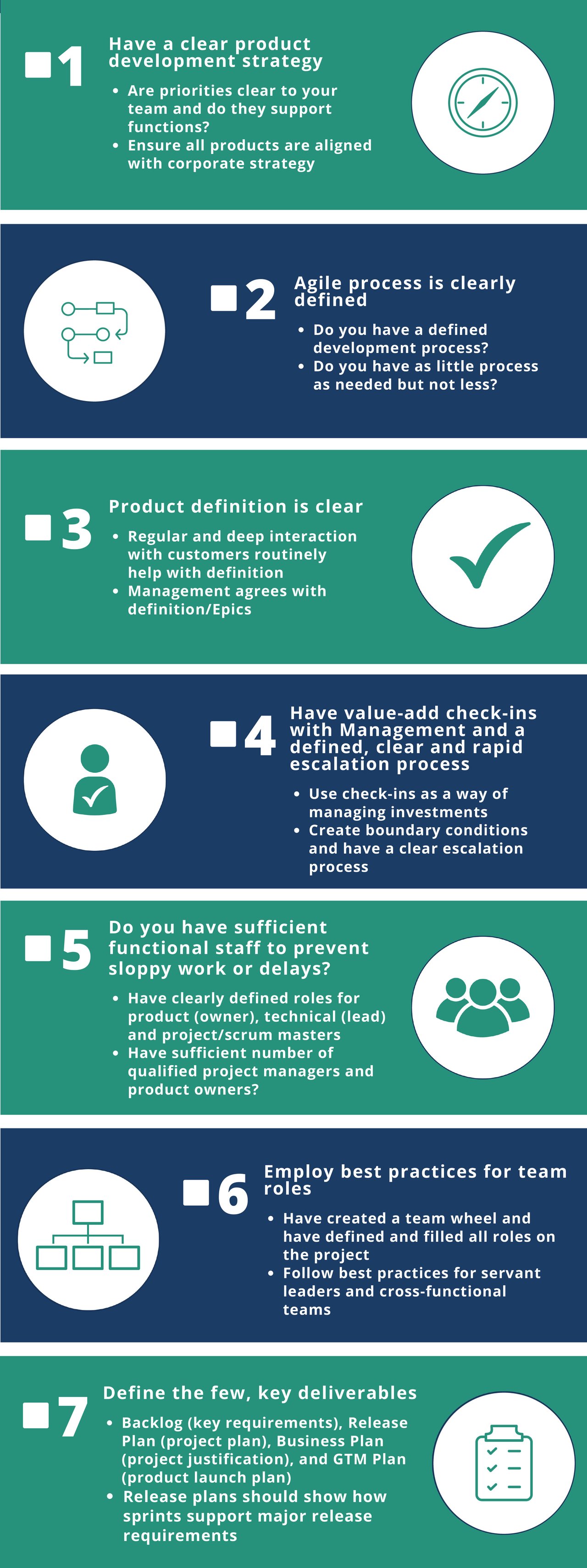Product Development Checklist
Product Development Checklist
In our work as product development consultants with companies like Apple, Amazon, Abbott, Mozilla, Cisco, HP, IBM, Roche, 3M and others, we’ve seen many avoidable problems solved. We often see the same small number of challenges repeated over and over – issues that could have been resolved with a few simple but powerful distinctions, and simple practices that put them into action. We use a more detailed form of this checklist when assessing a new product development process, too.
“What do Johns Hopkins surgeons, anonymous big-time investors and World War II pilots have in common? …they all use checklists to avoid disaster.”
— “Checklist Manifesto” by Atul Gawande
The downloadable product development checklist below is based on our client work. It is designed to help you focus quickly on challenges. This checklist highlights seven areas for improvement in product development:
- Product Strategy – A clear and well-understood product strategy is a must. Dev teams and the functions (Marketing, Engineering, Finance, etc.) must understand the corporate strategy and how their work fits into corporate priorities.
- Product Development Process – The best product development processes are inherently Agile. They enable creative people to do their job, and then they get out of the way and let them do it. The most effective product development processes engage customers early on, and then iterate prototypes to provide real solutions.
- Product Definition – Teams that translate the voice of the customer into superb product definitions create winning new products. They have clear product requirements, and inbound marketing communicates them to the Dev team. Many companies do not spend near enough time defining products, while applying concepts such as Design Thinking. Cross functional teams must interact with customers (and even non-customers) to get their input unfiltered.
- Reviews – Best-in-class companies see reviews as check-ins. They are a way to make and protect investments, on the model of venture capitalists. When a team is chartered, they make a simple, high-level contract with management that stipulates the most important three-to-five dimensions for the project and product around variables like features, schedule, product cost, and quality. As long as the team remains within the bounds of this agreement, the management team leaves them alone. Applying exception management to product development keeps the check-ins few, far between, and focused on the essentials.
- Resources – One of the most common problems we see is teams that are under-resourced. Not only do organizations take on too many projects, often key skills like program and product management are in short supply. A lack of communication between the Dev team and the functions often leaves teams without proper resources. It is best practice to have few projects per project manager, and all projects require strong support from Product Management.
- Roles and Responsibilities – One of the most avoidable problems in product development is unclear team roles and responsibilities. The most important benefit of clarifying roles is that the team understands who is the DRI (Directly Responsible Individual) for key deliverables. A simple RACI diagram that shows who is directly responsible for what deliverable can go a long way toward resolving this basic (but maddening) issue.
- Deliverables – The deliverables the team produces for management along the Dev journey should be few and powerful. One common problem we see is that deliverables have become bloated, with unnecessary information that doesn’t help managers make decisions any better or faster. Have a few agreed upon documents, such as a Release Plan, Agreed Backlog, and Test Plan, and stick to them.
Checklist
Download Product Development Checklist
Download the product development checklist to identify gaps, and help you focus on best practices that improve product development.

